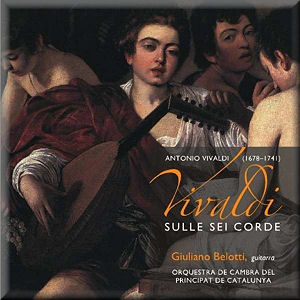 |
 |
|


alternatively
CD:
MDT
AmazonUK
AmazonUS
|
Antonio VIVALDI (1678 - 1741)
Vivaldi sulle sei corde
Trio for lute, violin and bc in C (RV 82) [10:38]
Trio for lute, violin and bc in g minor (RV 85) [08:14]
Concerto for lute, 2 violins and bc in D (RV 93) [10:39]
Concerto for mandolin, strings and bc in C (RV 425) [08:08]
Concerto for viola d'amore, lute, strings and bc in d minor (RV
540) [12:36]
Concerto for two mandolins, strings and bc in G (RV 532)*
[12:41]
 Giuliano Belotti, Carles Herrŕiz (*) (guitar), Kostadin Bogdanovski (violin**), Pablo Gastaminza (viola d'amore), Cristoforo Pestalozzi (cello**)
Giuliano Belotti, Carles Herrŕiz (*) (guitar), Kostadin Bogdanovski (violin**), Pablo Gastaminza (viola d'amore), Cristoforo Pestalozzi (cello**)
Orquestra de Cambra del Principal de Catalunya/Cristoforo Pestalozzi
rec. 2-4 July 2010, Estudis Albert Moraleda, La Garriga (Barcelona), Spain. DDD
 COLUMNA MÚSICA 1CM0265 [62:16]
COLUMNA MÚSICA 1CM0265 [62:16] 
|
|
|
Much has changed in the performance of baroque music over the
last forty years or so. In the 1970s and 1980s representatives
of historical performance practice had to justify the use of
period instruments. Today most recordings of baroque music feature
period instruments, and performers who play baroque music on
modern instruments are asked why they do so. The answers vary;
some are plausible, others far less so.
Some ensembles like to play music from all style periods, and
playing period instruments in baroque music and modern instruments
in contemporary music doesn't always work. In the booklet for
this disc the aim of the orchestra is described as making "little-know
jewels of the baroque music period accessible to modern audiences.
In this sense, they are set to be performed with modern instruments
more suitable for the acoustic requirements of modern concert
halls". This is a sensible argument, but then the question
is: why do they play in such acoustical circumstances? Wouldn't
it be preferable to look for appropriate venues rather than
adapt the music to venues which are not really suited to the
repertoire?
Even so, this argument makes more sense than what is written
a little earlier in the liner-notes in regard to the decision
to play Vivaldi's music for lute or mandolin on the modern guitar.
"Today, the modern classical guitar seems to give new tone-colour
possibilities to these works, as does the piano in comparison
to the harpsichord". As such that may be true, but do Vivaldi's
works gain from those "new tone-colour possibilities"?
I don't think so. It also needs to be noted that Vivaldi himself
never composed any sonata or concerto for guitar.
That said, these performances are quite good, although there
are some deficits. These have mainly to do with the balance
between the instruments. The disc begins with two trios for
lute, violin and bc. Here the balance between the two treble
instruments is unsatisfying as the guitar overshadows the violin.
In the third piece it is just the opposite. The number of players
is not given, but I am sure more than two violins are playing
here, and as a result the guitar is under-exposed when all instruments
are participating. In all three pieces the basso continuo is
too weak. That is largely due to the lack of a harpsichord.
The Concerto in C (RV 425) is one of the best parts of
this disc. Here the balance is mostly right, and the strings
play quite well. Also good is the Concerto in d minor (RV
540) in which the viola d'amore part is beautifully played by
Pablo Gastaminza. He has been a pupil of Wim ten Have, a member
of Frans Brüggen's Orchestra of the 18th Century. He also plays
in various early music groups. That is an indication that these
performances are influenced by historical performance practice,
and is quite noticeable at several points in these recordings.
The vibrato of the strings is minimal. Also there is a clear
differentiation between good and bad notes and there is dynamic
gradation on long notes. The largo from the Concerto in d
minor bears witness to that. There is a sweetness of sound
here whereas in the opening movement of the Concerto in G
(RV 532) the sound is rather coarse.
Giuliano Belotti performs the solo parts quite well. He shows
a stylistic awareness in the differentiated treatment of the
notes and in the addition of ornaments. On the other hand the
modern guitar is not a suitable replacement for the lute and
the mandolin. It is too loud and it lacks the delicacy of these
instruments. The solo parts clearly suffer from that.
The programme has been well recorded, but it is quite odd that
the disc ends with three and a half minutes of silence. Therefore,
don't be surprised that your CD player indicates that it lasts
65:39.
The booklet, in Catalan, Spanish and English, offers mainly
biographical information about the players, but tells us nothing
about Vivaldi's music. The liner-notes begin by stating that
Vivaldi is mainly known for his 'Four Seasons'. But that was
a long time ago. Today it’s no longer necessary to emphasize
that he wrote much more. Every year many new recordings of his
music are released. But the author seems to be a bit out of
touch with our time anyway: the concertos recorded here are
certainly not "little-known jewels" as they have been
recorded many times.
This disc will probably not appeal to those music-lovers who
prefer to hear Vivaldi's music in its original state. Guitar
aficionados should love it. Giuliano Belotti is a fine player,
the music is entertaining and the performances as stylish as
possible with modern instruments.
Johan van Veen
http://www.musica-dei-donum.org
https://twitter.com/johanvanveen
|
|

